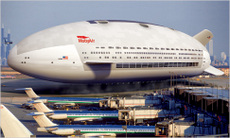 This is how we may travel across the continent or oceans in the future. Because it is not lighter-than-air, it is not a blimp. On the other hand, it requires no runway, because it takes of vertically with massive jet engines.
This is how we may travel across the continent or oceans in the future. Because it is not lighter-than-air, it is not a blimp. On the other hand, it requires no runway, because it takes of vertically with massive jet engines.
Unlike a plane, you don’t sit in passenger seats. Instead, it’s similar to a cruise. The interior cabin is one acre, and you can stoll around, visit casinos, etc. Or you can retire to your stateroom:
This two-football-fields-long concept airship is the brainchild of Igor Pasternak, whose privately-funded California firm, Worldwide Aeros Corporation, is in the early stages of developing a prototype and expects to have one completed by 2010. Pasternak says several cruise ship companies have expressed interest in the project, and for good reason: The craft would have a range of several thousand miles and, with an estimated top speed of 174 mph, could traverse the continental U.S. in about 18 hours. During the flight, passengers would peer at national landmarks just 8,000 feet below or, if they weren’t captivated by the view, the cavernous interior would easily accommodate such amenities as luxury staterooms, restaurants, even a casino.
To minimize noise, the aft-mounted propellers will be electric, powered by a renewable source such as hydrogen fuel cells. A sophisticated buoyancy-management system will serve the same purpose as trim on an airplane, allowing for precise adjustments in flight dynamics to compensate for outside conditions and passenger movement. The automated system will draw outside air into compartments throughout the ship and compress it to manage onboard weight.
The company envisions a cargo-carrying version that could deliver a store’s worth of merchandise from a centralized distribution center straight to a Wal-Mart parking lot or, because the helium-filled craft will float, a year’s worth of supplies to an offshore oil rig. "You can land on the snow, you can land on the water," Pasternak says. "It’s a new vision of what can be done in the air."

